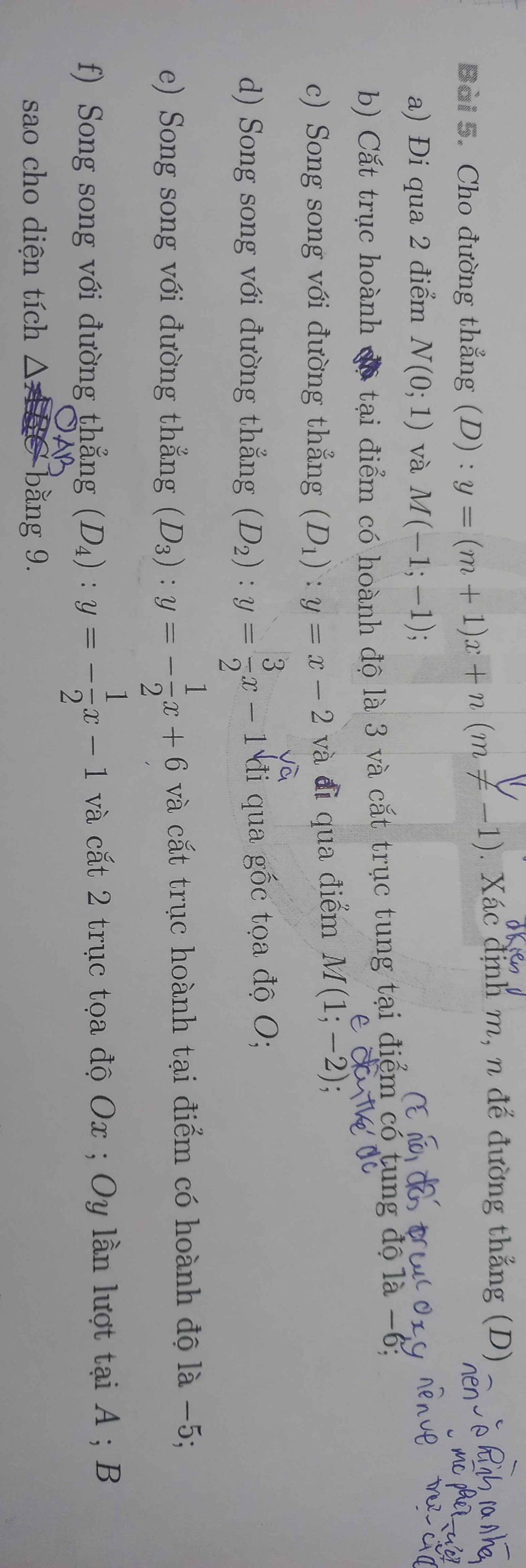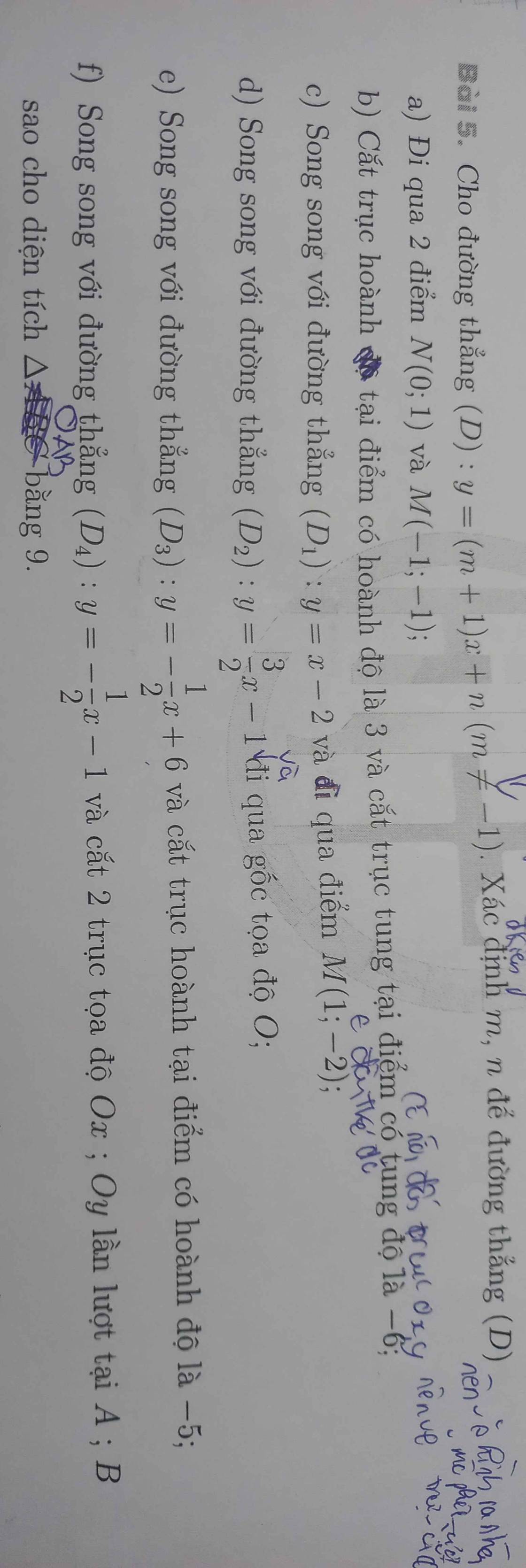Cho hai đường thẳng: (D):2m(m+1)x-y=-m-1 và (D’):4(m-2)x+y=3m-1. Xác định m để D//D’
Hãy nhập câu hỏi của bạn vào đây, nếu là tài khoản VIP, bạn sẽ được ưu tiên trả lời.


(d): 2m(m+1)x-y=-m-1\(\Leftrightarrow\)y=(2m2 +2m)x+m+1
(d'): 4(m-2)x+y=3m-1 \(\Leftrightarrow\)y=3m-1-4(m-2)
để (d)// (d') thì \(\left\{{}\begin{matrix}2m^2+2m=4m-8\\3m-1\ne m+1\end{matrix}\right.\Leftrightarrow\left\{{}\begin{matrix}m^2-m+4=0\\2m\ne2\end{matrix}\right.\)
\(\Leftrightarrow\left\{{}\begin{matrix}\left(m-\frac{1}{2}\right)^2+\frac{15}{4}=0\left(VL\right)\\m\ne1\end{matrix}\right.\)

Lời giải:
a. Với $m=1$ thì ptđt $(d)$ là: $y=x+1$
b. Trung điểm của 2 đường thẳng??? Đường thẳng thì làm gì có trung điểm hả bạn? Đoạn thẳng thì có.
c. $(d)$ cắt $y=x-2$ tại điểm có hoành độ $-1$
$\Leftrightarrow$ PT hoành độ giao điểm $(2-m)x+2m-1-(x-2)=0$ nhận $x=-1$ là nghiệm
$\Leftrightarrow (2-m)(-1)+2m-1-(-1-2)=0$
$\Leftrightarrow m=0$

b: Phương trình hoành độ giao điểm là:
-x+3=-2x+1
\(\Leftrightarrow x=-2\)
Thay x=-2 vào y=-x+3, ta được;
y=2+3=5
Thay x=-2 và y=5 vào (d), ta được:
\(-2\left(2-m\right)+2m-1=5\)
\(\Leftrightarrow2m-4+2m-1=5\)
\(\Leftrightarrow4m=10\)
hay \(m=\dfrac{5}{2}\)

\(a,\Leftrightarrow A\left(0;0\right)\in\left(d\right)\Leftrightarrow-2m+1=0\Leftrightarrow m=\dfrac{1}{2}\\ b,\Leftrightarrow x=3;y=4\Leftrightarrow3\left(m+1\right)-2m+1=4\\ \Leftrightarrow3m+3-2m+1=4\\ \Leftrightarrow m=0\Leftrightarrow\left(d\right):y=x+1\\ c,\text{PT hoành độ giao điểm: }x+1=-2x+4\Leftrightarrow x=1\Leftrightarrow y=2\Leftrightarrow B\left(1;2\right)\\ \text{Vậy }B\left(1;2\right)\text{ là giao 2 đths}\)

a: Để hàm số y=(2m+3)x-2m+5 nghịch biến trên R thì 2m+3<0
=>2m<-3
=>\(m< -\dfrac{3}{2}\)
b: Để (d)//(d1) thì
\(\left\{{}\begin{matrix}2m+3=3m-2\\-2m+5\ne1\end{matrix}\right.\)
=>\(\left\{{}\begin{matrix}-m=-5\\-2m\ne-4\end{matrix}\right.\Leftrightarrow\left\{{}\begin{matrix}m=5\\m\ne2\end{matrix}\right.\)
=>m=5
c: Thay y=5 vào y=3x-1, ta được:
3x-1=5
=>3x=6
=>x=6/3=2
Thay x=2 và y=5 vào (d), ta được:
\(2\left(2m+3\right)-2m+5=5\)
=>\(4m+6-2m+5=5\)
=>2m+11=5
=>2m=-6
=>m=-6/2=-3
d: Tọa độ A là:
\(\left\{{}\begin{matrix}y=0\\\left(2m+3\right)x-2m+5=0\end{matrix}\right.\)
=>\(\left\{{}\begin{matrix}y=0\\x\left(2m+3\right)=2m-5\end{matrix}\right.\Leftrightarrow\left\{{}\begin{matrix}y=0\\x=\dfrac{2m-5}{2m+3}\end{matrix}\right.\)
=>\(A\left(\dfrac{2m-5}{2m+3};0\right)\)
\(OA=\sqrt{\left(\dfrac{2m-5}{2m+3}-0\right)^2+\left(0-0\right)^2}=\sqrt{\left(\dfrac{2m-5}{2m+3}\right)^2}=\left|\dfrac{2m-5}{2m+3}\right|\)
Tọa độ B là:
\(\left\{{}\begin{matrix}x=0\\y=x\left(2m+3\right)-2m+5=0\left(2m+3\right)-2m+5=-2m+5\end{matrix}\right.\)
=>\(B\left(-2m+5;0\right)\)
\(OB=\sqrt{\left(-2m+5-0\right)^2+\left(0-0\right)^2}\)
\(=\sqrt{\left(-2m+5\right)^2}=\left|2m-5\right|\)
Vì Ox\(\perp\)Oy
nên OA\(\perp\)OB
=>ΔOAB vuông tại O
=>\(S_{OAB}=\dfrac{1}{2}\cdot\left|2m-5\right|\cdot\dfrac{\left|2m-5\right|}{\left|2m+3\right|}\)
\(=\dfrac{1}{2}\cdot\dfrac{\left(2m-5\right)^2}{\left|2m+3\right|}\)
Để \(S_{AOB}=1\) thì \(\dfrac{\dfrac{1}{2}\left(2m-5\right)^2}{\left|2m+3\right|}=1\)
=>\(\dfrac{\left(2m-5\right)^2}{\left|2m+3\right|}=2\)
=>\(\left(2m-5\right)^2=2\left|2m+3\right|\)
=>\(\left(2m-5\right)^2=2\left(2m+3\right)\)
=>\(4m^2-20m+25-4m-6=0\)
=>\(4m^2-24m+19=0\)
=>\(m=\dfrac{6\pm\sqrt{17}}{2}\)


Để hai đường song song thì 2m(m+1)=-4(m-2)
=>2m^2+2m+4m-8=0
=>2m^2+6m-8=0
=>(m+4)(m-1)=0
=>m=1 hoặc m=-4